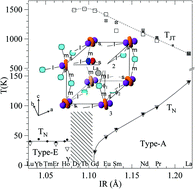Orbital ordering in orthorhombic perovskites
Abstract
In addition to a cooperative MO6/2 site rotation, orthorhombic AMO3 perovskites with Pbnm space group have a universal, intrinsic MO6/2 site distortion consisting of an orthorhombic component and a reduction from 90° of the O–M–O bond angle α that subtends the octahedral-site edges parallel to the orthorhombic b axis. RMO3 perovskites (R = rare earth or Y, M = 3d-block transition metal) exhibit a maximum intrinsic orthorhombic site distortion at an R3+-ion radius


 Please wait while we load your content...
Please wait while we load your content...